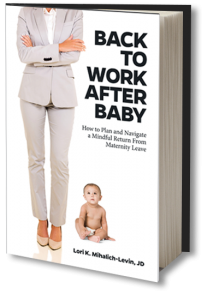 Ready to give up the ubiquitous – but rather inaccurate – term “work-life balance” this year? Dr. Emma Basch joins us again on the Mindful Return blog to offer her preferred alternative to the concept: embracing the idea of “swaying.” Here’s Dr. Basch with 8 concrete suggestions that will help you feel more confident about that working mama juggling act.
Ready to give up the ubiquitous – but rather inaccurate – term “work-life balance” this year? Dr. Emma Basch joins us again on the Mindful Return blog to offer her preferred alternative to the concept: embracing the idea of “swaying.” Here’s Dr. Basch with 8 concrete suggestions that will help you feel more confident about that working mama juggling act.
**********************************************************************************
It’s that time of year again. ‘Tis the season for New Year’s resolutions. For many of my clients, the new year brings a new-found commitment to finding “balance” in their lives. Specifically, the desire for better “work-family balance” is something I hear about from clients throughout the year, with increased fervor during this season.
But what if I told you you’re striving for the wrong thing? That the concept of work-family balance is a set up for disequilibrium? Picture a set of scales, with “work” and all that entails on one side. And “family” and all that entails on the other. Unless things are perfectly even, what happens? The scale shakes and quivers and is perpetually striving for center. Sounds a bit like what life looks like as a working parent, right?
The paradigm that somehow work life and family life will steady themselves evenly just doesn’t hold. First, inevitably one area of your life will demand more attention. Your child gets sick. You have a big project at work. Something is always bound to tip the scales. Second, what about all the other aspects of life that have value such as spending time with friends, being with a partner, finding time for yourself? They aren’t even included in this equation.
So, what if instead of balance, we strive for flexibility?
Or as I often tell my clients, we learn to embrace the idea of swaying.
To illustrate this, I ask my clients to conjure the image of a skyscraper. In order to construct a massive building, structural engineers design skyscrapers to sway back and forth. This allows them to alleviate pressure caused by natural forces such as wind or earthquakes. In other words, these buildings are stronger, because they sway. They are stable, because they are flexible. So how does this translate to managing life as a working parent? The more you are able to be flexible with yourself and in your approach, the steadier you will feel.
Here are 8 concrete ideas on how to sway:
- Practice Mindfulness: Mindfulness refers to an intentional, non-judgmental awareness of the present moment. Practicing mindfulness enables us to slow down and observe our emotional experience, which in turn makes us less reactive and more aware of the shifting nature of our feelings and our circumstances. In this context, practicing mindfulness may help you to feel less overwhelmed by the various responsibilities in your life. More present in each domain. And better able to sway with shifting demands. As place to start, try spending time each day focusing on mindful breathing, or pick a task you do daily such as drinking a cup of coffee or brushing your teeth, and practice doing it while engaging with all five senses.
- Shift Your Thinking: Pay attention to the way you are thinking about your role as a working parent. The language you use, the expectations you set, and the way you frame your role all impact your ability to be flexible. For example, look out for the use of “shoulds” and “musts” in the expectations you set for yourself or others. As I’ve written about previously, this way of thinking creates arbitrary rules which are a set up for guilt and rigidity.
- Plan for the Unexpected: As Lori so brilliantly outlines in her book, when you sit down over the weekend to look at your schedule for the week ahead, take the time to make contingency plans and to assess the various demands of the week. Who will stay home if your child gets sick or your nanny has the day off? Should you anticipate staying late at work because of an approaching deadline? Is this a week you may have more time to fit in time for yourself? This sets a tone for the week that acknowledges and plans for the need to sway.
- Have Options for Self-Care: Speaking of time for yourself, making the time for self-care is essential in helping you to maintain the emotional capacity to be flexible. I have my clients create a menu of options for self-care that range in the amount of time and effort they take to engage in and ask them to keep this list somewhere handy such as on their phone. This creates more flexibility which in turn makes it easier to prioritize and engage in self-care.
- Take it Day by Day (or Better Yet, Moment to Moment): To the extent that you can, try to take it one day at a time. Or even a minute at a time. If today, or part of today, you felt that work demanded more of your time than you would like, remember that it will shift and change.
- Wherever You Go, There You Are: Remember that all parts of your identity, your priorities, and the responsibilities that come with them, accompany you no matter what domain you are in. In other words, you are still very much a parent when you are at work, and you are still a working person when you are caretaking. I’ve observed that a lot of my clients feel frustrated and overwhelmed by this, which leads to difficulty being flexible. If you can first embrace this idea, you can than implement flexible buffers and boundaries to help protect your time at work or at home. For example, rather than feeling frustrated by the kid-related tasks that need to be done during the work day, accept first that this is part of being a working parent. And from there, come up with some creative solutions to protect your work time, such as designating a specific time during your workday when you tackle these types of tasks. Similarly, when you get home from work, recognize that work may demand your attention at some point. But can you institute a phone-free hour to spend mindfully with your child first?
- Practice Self-Compassion: Learning how to sway means learning to be ok with feeling unsteady at times and with embracing uncertainty. While ultimately being flexible in this way will help you to feel more grounded, adopting this mindset is challenging. Being a parent, working, being a partner, taking care of yourself, it is all challenging at times. I encourage my clients to actively practice self-compassion. More specifically, make it a priority to treat yourself with kindness and understanding.
- Make Changes Where You Can: Sometimes, the demands of one area of your life feel so heavily weighted that being flexible may feel insufficient. For example, let’s say you work at a company that expects 50+ hours a week of work, and there doesn’t feel like there is much time for anything else. In this case, learning to sway may first mean finding flexibility with yourself. Are you setting unreasonable expectations for your capacity to engage in responsibilities outside of work? Are your standards for yourself fair? Do you have the supports in place that you need? Are there ways to advocate for yourself at work that enable more flexibility?
If it still feels as though there is no room for flexibility, I’d encourage you to think about what is most important to you in each of the domains of your life. See if you can make some small changes that enable you to sway more. In doing this values assessment, you may find that your current structure does not enable any degree of flexibility and is not consistent with what you care most about, at least some of the time. If this is the case, it may be time to make larger changes.
Learning to sway may not feel easy, but it will produce more ease in your life. Working towards a more flexible mindset will help you feel less overwhelmed and more present in your various life domains. If you are struggling to shift your thinking and find that you are feeling shaky in the face of daily stressors, you may find it helpful to connect with a mental health professional who specializes in working with new parents and who can help you embrace the sway.
 Emma Basch is a licensed clinical psychologist with a specialty in women’s mental health, reproductive psychology, and the perinatal period. She maintains a private practice in Washington, DC where she works with individuals and groups around issues concerning perinatal mood and anxiety disorders, fertility, pregnancy loss, and adjustment to parenthood. Emma also writes frequently on topics concerning reproductive health, offers trainings on the subject to allied professionals, and offers workshops around DC for pregnant and postpartum women. She has received training from the Postpartum Stress Center and Postpartum Support International.
Emma Basch is a licensed clinical psychologist with a specialty in women’s mental health, reproductive psychology, and the perinatal period. She maintains a private practice in Washington, DC where she works with individuals and groups around issues concerning perinatal mood and anxiety disorders, fertility, pregnancy loss, and adjustment to parenthood. Emma also writes frequently on topics concerning reproductive health, offers trainings on the subject to allied professionals, and offers workshops around DC for pregnant and postpartum women. She has received training from the Postpartum Stress Center and Postpartum Support International.
 Want to join an authentic, supportive community of new working moms heading back to work around the time you are? Join the next session of Mindful Return.
Want to join an authentic, supportive community of new working moms heading back to work around the time you are? Join the next session of Mindful Return.
Want more practical tips on working parenthood? Check out my book, Back to Work After Baby: How to Plan and Navigate a Mindful Return from Maternity Leave.


